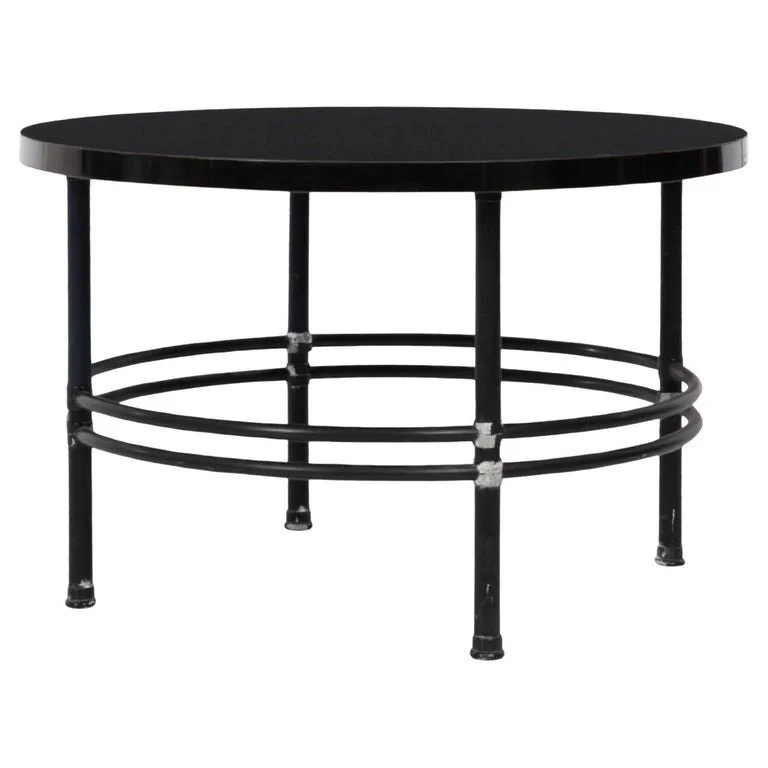Warren McArthur Streamline Modern Aluminum Black Coffee Table Model 1559-s 1930s
Warren McArthur Streamline Modern Aluminum Black Coffee Table Model 1559-s 1930s
Warren McArthur
Coffee table, model 1559-s
Warren McArthur Corporation
USA, c. 1930
enameled aluminum, laminate
18½ h × 30 dia in (47 × 76 cm)
literature: Warren McArthur Corporation, Donnelly, pg. 50
Warren McArthur Jr. was an innovator in Machine Age/ Art Deco furniture design.
McArthur moved from Chicago to Los Angeles in 1929 to pursue metal furniture manufacturing; he founded the Warren McArthur Corporation there in 1930. His furniture designs while unique were true to the Machine Age aesthetic. Machine Age design emphasized sleek forms inspired by automobiles, locomotives and airplanes. These objects were symbols of progress and modernity to the American consumer and industrial designers began constructing furniture in streamlined designs from steel, chrome and aluminum.
Prior to the 1933 Chicago World’s Fair, known as the “Century of Progress Exhibition.” The fair’s tagline, “See America Streamlined,” and the abundance of metal furniture and home goods exhibited finally presented the concept of utilizing metal designs in the typical American household. The Museum of Modern Art followed suit in subsequent years with exhibitions like "Machine Art," (1934), and "Bauhaus 1919-1928" (1938), further exposing the American public to this design style.
The Warren McArthur Corporation moved manufacturing to Rome, New York in 1933, just as metal furniture was gaining popularity; the company’s products were sold out of a showroom in New York City on Park Avenue. As a manufacturer, McArthur filed numerous patent designs which he utilized in advertisements to exhibit the innovations he developed. The company also proudly printed patent numbers on furniture labels. This demonstrated to the customer that they were purchasing unique, scientifically designed, and thus inherently modern, furniture.
For both durability and comfort, McArthur’s tubular aluminum furnishings were constructed with an internal tension rod within the aluminum frame. This construction provided a slight ‘give’ which was believed to be a sign of quality and provide a higher level of comfort in chairs. McArthur’s innovative products achieved “maximum strength with a minimum of weight, while also permitting the attainment of a desirable attractiveness in appearance.” The internal rods are the backbone of any McArthur furniture frame - the exteriors composed of multiple pieces of tubular aluminum, held together inside by the rods and outside by the joinery.
The structural joints were another unique aspect of McArthur furnishings, elucidated in the same patent. Ever concerned with aesthetics, McArthur developed joinery that would not detract from his designs. The joints allowed for easy disassembly and reassembly because they did not use small screws, nails or other pieces that could be misplaced. In essence, the joints are composed of internal washers that affix the small portions of aluminum tube together over the internal rods. These interior parts are held together on the exterior by smooth or notched aluminum braces.
With the outbreak of World War II, aluminum in the United States was prohibited for private use. McArthur applied his talents to the war effort and designed aircraft seating for the Air Force and Navy, utilizing his expertise with the material. Unfortunately, after the war Machine Age design had fallen out of style and the Warren McArthur Corporation eventually closed shop in 1948.
Literature:
Edwards, Clive. "Aluminium Furniture, 1886-1986: The Changing Applications and Reception of a Modern Material." Journal of Design History 14, no. 3 (2001): 207-25.
Kirkham, Pat and Susan Weber. History of Design: Decorative Arts and Material Culture, 1400-2000. (New York: The Bard Graduate Center: Decorative Arts, Design History, Material Culture, 2013)
"Modern Solutions." Art Institute of Chicago Museum Studies 27, no. 2 (2001): 47-110.
Moonan, Wendy. "ANTIQUES; Rediscovered: Early Master of Metal." The New York Times, August 27, 1999, Arts sec.
Wilson, Richard Guy, et al. The Machine Age In America: 1918 - 1941. Japan: Times Mirror Books, 1986.
Warren McArthur Furniture Ltd. “Furniture”. 1933: n. pag. Google Patents. Accessed February 2, 2017.

